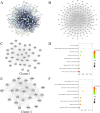Exploring the beneficial effect of gut microbiota metabolites on diabetic nephropathy via network pharmacology study
- PMID: 40164705
- PMCID: PMC11958680
- DOI: 10.1038/s41598-025-95824-y
Exploring the beneficial effect of gut microbiota metabolites on diabetic nephropathy via network pharmacology study
Abstract
Diabetic nephropathy (DN) is one of the severe complications of diabetes, current treatment against DN is still limited. It is suggested that gut microbiota metabolites will be a promising alternative therapy against DN. In this study, we explore the beneficial effect of gut microbiota metabolites on DN via employing network pharmacology study. The targets of metabolites were screen from Similarity Ensemble Approach (SEA) and Swiss Target Prediction (STP). The DN targets were acquired from disease database. The intersecting targets of metabolites and DN were considered crucial targets. The Protein-Protein Interaction (PPI) networks, GO function and KEGG analysis were conducted to identify core target and key signaling pathway. A "Microbiota-Substrate-Metabolites-Targets" network was built to screen the core metabolites. Molecular docking was employed to assess the binding affinity between metabolites and targets. GO functional results indicated that the metabolites were mainly enriched in oxidative stress and inflammation. PPARG, AKT1, IL6 and JUN were the top 4 targets of gut microbiota metabolites regulating DN. Butyrate, Acetate, Indole and 3-Indolepropionic acid were the core gut microbiota metabolites that had beneficial effects on attenuating DN. Molecular docking results indicated that 3-Indolepropionic acid displayed a good binding affinity toward targets of PPARG, AKT1, IL6 and JUN. Our study revealed that the gut microbiota metabolites might exert beneficial effect on attenuating DN by regulating multi-signaling pathway and multi-targets. This work offers us a novel insight into the mechanism of DN from the perspective of beneficial benefits of gut microbiota metabolites.
Keywords: Diabetic nephropathy; Gut microbiota; Gut microbiota metabolites; Network pharmacology.
© 2025. The Author(s).
Conflict of interest statement
Declarations. Competing interests: The authors declare no conflicts of interest related to this study. Ethical approval and consent to participate: This study does not involve any human or animal experiment. The ethical statement is not applicable.
Figures







Similar articles
-
Exploring the health benefits of gut microbiota metabolites on combating ulcerative colitis via network pharmacology, bioinformatics and molecular docking.Sci Rep. 2025 Jul 15;15(1):25626. doi: 10.1038/s41598-025-10851-z. Sci Rep. 2025. PMID: 40664846 Free PMC article.
-
Elucidating the role of gut microbiota metabolites in diabetes by employing network pharmacology.Mol Med. 2024 Dec 20;30(1):263. doi: 10.1186/s10020-024-01033-0. Mol Med. 2024. PMID: 39707185 Free PMC article.
-
Network pharmacology, molecular docking, and experimental verification to reveal the mechanism of colquhounia root tablet in the treatment of diabetic nephropathy.Biochem Biophys Res Commun. 2025 Jan;745:151086. doi: 10.1016/j.bbrc.2024.151086. Epub 2024 Dec 24. Biochem Biophys Res Commun. 2025. PMID: 39740397
-
Integrating network pharmacology, molecular docking and simulation approaches with machine learning reveals the multi-target pharmacological mechanism of Berberis integerrima against diabetic nephropathy.J Biomol Struct Dyn. 2025 Mar;43(4):2092-2108. doi: 10.1080/07391102.2023.2294165. Epub 2024 Feb 20. J Biomol Struct Dyn. 2025. PMID: 38379386 Review.
-
Gut Microbiota and Their Metabolites: The Hidden Driver of Diabetic Nephropathy? Unveiling Gut Microbe's Role in DN.J Diabetes. 2025 Apr;17(4):e70068. doi: 10.1111/1753-0407.70068. J Diabetes. 2025. PMID: 40189872 Free PMC article. Review.
References
-
- Saeedi, P. et al. Global and regional diabetes prevalence estimates for 2019 and projections for 2030 and 2045: Results from the international diabetes federation diabetes atlas, 9(th) edition. Diabetes Res. Clin. Pract.157, 107843. 10.1016/j.diabres.2019.107843 (2019). - PubMed
-
- Liu, W. et al. Global trends in the burden of chronic kidney disease attributable to type 2 diabetes: An age-period-cohort analysis. Diabetes Obes. Metab.26, 602–610. 10.1111/dom.15349 (2024). - PubMed
-
- van Raalte, D. H. et al. Combination therapy for kidney disease in people with diabetes mellitus. Nat. Rev. Nephrol.20, 433–446. 10.1038/s41581-024-00827-z (2024). - PubMed
-
- Sebastian, S. A., Padda, I. & Johal, G. Cardiovascular-kidney-metabolic (CKM) syndrome: A state-of-the-art review. Curr. Probl. Cardiol.49, 102344. 10.1016/j.cpcardiol.2023.102344 (2024). - PubMed
MeSH terms
Grants and funding
- SHGZS-202237/Shanghai Famous Traditional Chinese Medicine Academic Experience Research Studio Construction Project
- ZYTSZK2-13/Shanghai 14th Five-Year Plan TCM Characteristic Specialty Construction Project
- JSZK2023H04/The Seventh Cycle Key Medical Specialty Establishment Project in Jinshan District of Shanghai
- QJZXYJK-202408/Shanghai District-Level Comprehensive (Specialized) Hospital's Integrated Traditional Chinese and Western Medicine Specialty Capacity
LinkOut - more resources
Full Text Sources
Medical
Miscellaneous

